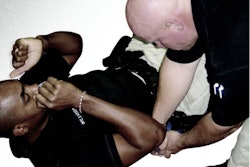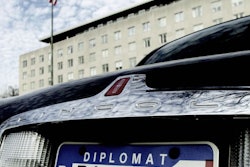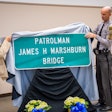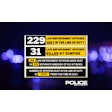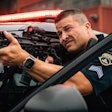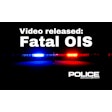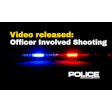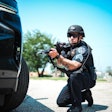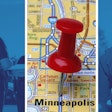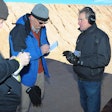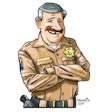About 24 hours before Hurricane Katrina struck the Gulf Coast Capt. John Bryson of the New Orleans Police Department was in a McDonald's in the city's Ninth Ward buying a cup of coffee. Next to him in line was a woman and her four children; the youngest was a one-year-old baby.
Bryson spent the next few minutes making a futile attempt to persuade this lady to evacuate. "I begged her to leave," says Bryson, commander of the NOPD's Fifth District, which encompasses the Ninth Ward and the Lower Ninth Ward.
She dismissed Bryson's concern with tragic diffidence. "She told me it was going to miss us," he says. Bryson argued and pleaded, but she didn't hear him. He picked up his coffee, started to leave, and played his final card. "I told her, 'This is a killer storm. So please do us a favor. Write your name, Social Security number, and an emergency contact number on your arm and on your children's arms. There's a strong possibility that none of you will survive it.' She looked at me disbelieving. I said, 'Ma'am, this is a killer storm.'"
Bryson doesn't know what happened to the lady in the McDonald's. He prays that she and her babies made it out alive. But more than a month later in a phone interview, he doesn't know. And he fears they may be among the "HRs" (human remains) that the New Orleans police are still recovering from his district.
Prelude to Disaster
The U.S. Weather Service will tell you that Hurricane Katrina made landfall in the lower Mississippi delta town of Buras, La., at 7 a.m. Central Standard Time on Monday Aug. 29.
That statement does nothing to convey how big the storm was, how well formed, and how much damage the outer bands of a Category 4 hurricane can do long before the eye comes ashore. If you want information on that, talk to the cops who were out in the streets trying to get people to head to higher ground as the storm intensified around them.
In the Fifth District of New Orleans, the men and women under Bryson's command spent Saturday and Sunday trying to get people to evacuate. But very early Monday morning, Bryson knew that mission was over.
"I was driving down the street in an Expedition at 1:30 that morning, and the wind was hitting the side so hard that I was on two wheels," says Bryson. "I almost flipped over, and I knew it was time to get my people off the streets.
"Bryson had a hard time getting his officers to obey his orders to come in. They were too busy trying to evacuate people. "It was three in the morning, we had 135-mph sustained winds and the water was rising, and I was begging my officers to come off the street.
"Elsewhere in the Big Easy, a variety of NOPD units were sheltering in pre-designated positions, waiting for the storm to pass or at least decrease in intensity so that they could move out to respond to the disaster. The tactical team and its critical equipment, including the personally owned boats of some officers, took cover in an elevated parking deck in the downtown area, the chief's staff was in the Hyatt-Regency Hotel across from the Louisiana Super Dome where some 30,000people had already sought shelter, and the vice and narcotics division had moved its officers to the Maison Dupuy Hotel.
Before the storm had completely passed, a detachment of Capt. Jeffrey Winn's tactical team braved the high winds and blistering rain to recon the area. They came back with reports of debris-filled streets and rising water.
The Bywater Hospital
The tac team's report was old news to Bryson. When he called his officers off the street at 3 a.m. Monday, they re-grouped at the nearby Bywater Hospital to ride out the storm. The hospital was supposed to have been evacuated. But Bryson and his Fifth District officers were in for a surprise.
There was a long-term care facility on the third floor and 49 patients still had to be evacuated. When the electricity went down, those patients were in trouble.
"We had a generator there that we were told would last at least seven days before it ran out of diesel," Bryson says. "The hurricane knocked out the electricity and, then about 2 a.m., the generator went under water and that took it out."
No power meant that patients in the long-term care facility who were on respirators had to be bagged. NOPD officers and nurses took turns bagging those patients for as long as 12 hours before they could be evacuated.
Throughout the storm and into the morning, Fifth District officers worked to evacuate the patients. The operation was conducted in the dark using flashlights and candles. They had to move the patients, some of whom weighed as much as 450 pounds, down three flights of stairs and through the ground floor of the hospital, which was flooded.
Carrying people through three feet of floodwater is not pleasant. It was even nastier at the Bywater Hospital, where the rising waters knocked over bio-hazard containers filled with used needles, bloody gauze, dirty bandages, and other biomedical waste. Six officers involved in the Bywater evacuation contracted severe staph infections.[PAGEBREAK]
We Need Boats
By 9 a.m. Monday, the worst of the winds had passed. The flood was just beginning.
What was left of the NOPD's communication system crackled with urgent requests for aid from Capt. Bryson. The Ninth Ward and the Lower Ninth were flooded and people were scrambling on to their rooftops to escape the rising waters. The tactical team started to respond to the call. They were joined by the officers of the vice and narcotics division who had no specific mission and were operating independently, scrounging for equipment and vehicles throughout the unflooded portions of the city.
"We knew we had water and that we were in trouble," says Capt. Tim Bayard, commander of the narcotics and vice division. "So I sent my guys out in their trucks to take the trailer balls off any truck they saw with a trailer ball. Then we went out and got boats."
The tactical team and the narcotics and vice officers rallied at Harrah's Casino on the high ground on the banks of the Mississippi River. They made the casino their operations center. Then they set out to make boat rescues in the Ninth Ward.
But first, they had to find a route into the Ward through city streets that were blocked with rubble and fallen trees. Debris had to be chainsawed out of the way and large trees had to be towed off the road by trucks with chains.
On the ramps leading down from Interstate 10, the tac team and the narcotics officers launched their boats. Once in the water, the officers navigated their craft down flooded streets, steering around debris and sunken vehicles. It was in a word, hairy.
It was even hairier when they got to the Ninth Ward. "It was very, very bad," says Winn. "Our guys had to cut through rooftops to get to people. We destroyed seven or eight chainsaws in the first day cutting through roofs."
The officers, firefighters, and civilians who were involved in the boat rescues in the Ninth Ward had to do a lot more than just float up to a house and help people into a boat. Many of the people they were rescuing wouldn't or couldn't swim, and they would not get in the water to board the boats.
So the emergency personnel on the boats had to jump in the water and swim the hurricane victims to safety. NOPD tactical officers even had to swim underwater to breach one dwelling, then bring the family through that underwater doorway, back up to the surface, and into the boats.
The boat rescues continued for about13 days, running even at night through the darkened and dangerous streets. Officers used large hunting Q beams and their personal flashlights to illuminate the operations.
A month later, Bayard marvels at what his narcotics and vice officers were able to accomplish. "What we knew about boat rescue operations you could fit in a thimble," Bayard says. "We didn't know anything about that. We had never done it before. But we knew we had to do it to save people."
All Hell Breaks Loose
Before, during, and after the storm, the NOPD had to cope with looting. After the storm and the flooding, it got a lot worse.
Desperate people broke into convenience and grocery stores looking for food, water, diapers, and medications. Hoodlums looted firearm, home entertainment, and jewelry stores.
Bryson and his Fifth District officers pulled back from the Ninth Ward after an early 23-hour shift. They stopped for a brief respite at the Port of Embarkation, a U.S. Naval base, then they moved to the Sheraton Hotel on Canal Street.
"We thought we were going to get to the hotel and be able to get some down-time," says Bryson. "But the minute we hit Canal Street, it was a mess. There was looting everywhere."
Bryson's officers immediately shifted gears from evacuation and rescue to looting suppression. "We didn't stop them from taking food," Bryson says. "But if we saw them coming out of Foot Locker with a bag of tennis shoes, then we took that and ran them up the street."
One of the problems that the NOPD faced with the looting after Hurricane Katrina was that it really couldn't make any arrests. The municipal holding facilities and the Orleans Parish jails were either inaccessible or flooded. All they could do was take the names and addresses of suspected looters, and tell them that they could be served warrants for looting sometime in the future.[PAGEBREAK]
Sniper Fire
Looting was only part of the mayhem that erupted in the Big Easy's streets after Katrina. Snipers and other shooters started firing on civilian rescue teams, fire-fighters, and police.
The result was a loss of assets for the rescue teams. Civilian boaters and fire-fighters had to pull back. The NOPD's tactical team had to repurpose from search and rescue to sniper suppression.
Tac team commander Winn will not give much detail of the counter-sniper actions that his men executed in the days immediately after Katrina. The incidents are all still under investigation.
He did, however, draw some skeletal outlines of some of these operations that anyone with an imagination can flesh out.
Snipers fired at emergency vehicles on the interstate. The tac team was tasked to provide escort. Snipers shot at repair crews trying to bring a critical cell tower back on line. The tac team entered a 300-unit, multi-story apartment complex and arrested two suspects.
"I can't really tell you what happened," says Winn. "The situation that followed the hurricane was a lawless situation. A very small part of the community was involved, but some people armed themselves and started to conduct criminal activity.
"Narcotics and vice commander Bayard is less diplomatic in expressing his feelings about the snipers. "Just knuckleheads," he says with disgust. "These are the kinds of people that we deal with on a daily basis. In a time of crisis we had guys who were rescuing people and the knuckleheads pulled guns on the rescuers."
Rescued Then Stranded
Throughout the week following Hurricane Katrina and the subsequent flooding, NOPD officers, firefighters, civilians, and soldiers from the U.S. Army's 20th Special Forces performed boat rescues in the Ninth Ward. They transported the people they rescued back to the boat launch point on Interstate 10.
And there, the rescued people waited. Exposed to the elements. No food. No water. No medical assistance. Temperatures reaching near 100. Humidity almost as high.
"We were moving a lot of people to safe ground," says Bayard. "But we didn't have anything that we could use to transport them to the evacuation sites. So we had people backed up 14 and 16hours waiting on the interstate. It was frustrating. The people we rescued the previous evening were still there the next day when we launched the boats."
The problem was that very few vehicles were available to transport the evacuees from I-10 to the evacuee centers at the Super Dome or the Convention Center. Most of the NOPD's fleet of vehicles was either drowned or inaccessible. City buses were flooded downtown and more than 60 school buses were under water in visual range of the overpass where the evacuees were gathered.
"The worst thing I saw," says Winn, "was there were 10,000 people walking on Interstate 10 trying to get to the Convention Center. Everything they owned was on their backs or in plastic bags."
At the Dome
Even if those evacuees on Interstate 10had reached the Convention Center or the Super Dome, they wouldn't have found any relief. Neither location had running water, food, or light, and the buildings were sweatboxes without air conditioning.
NOPD spokesman Officer Roland Doucett worked at the Louisiana Super Dome. He saw things there that still haunt him. The worst came during the evacuation of the building.
"It was horrifying," Doucett says. "The military set up barricades at the parking area of the dome. They would open up the gates and let out just enough people to fit a bus. So because of the pushing and shoving of the people who desperately wanted to get out, parents would be separated from their children."
Doucett says he can't even describe the conditions at the dome that the evacuees experienced or what it was like to work under those conditions. "I remember the kids and the old people most," he says. "There were old people in wheelchairs at the dome. And they couldn't get out of their chairs to urinate or defecate. So they sat for days in their own feces. When we evacuated them onto the buses, we had to pick them up. So you can imagine what we smelled like."
A Physical Toll
Like the rest of the NOPD working in the immediate aftermath of Hurricane Katrina, the only means that Doucett had to clean himself was with bottled water. Even though officers were living in luxury hotels, there was no running water, and no showers. Some bathed in hotel swimming pools and hot tubs, which quickly became fouled because there was no electricity to run their filters.
The lack of facilities for personal hygiene was only one of the hardships the officers faced. They worked 12- and 14-hour days with little rest and little food for nearly two weeks. "We worked 13 days in a row," says Bayard. "When we got off, we were fried."
Some officers were even more "fried" than others. "I didn't know my name by Friday," says Bryson, who was hospitalized with dehydration, exhaustion, and sleep deprivation. "They wanted to keep me for three days. We compromised at 12 hours and an IV."
It's not an exaggeration to say that the officers of the New Orleans Police Department went through hell in the immediate aftermath of Hurricane Katrina. But they fought back; they struggled against the elements; they battled criminals; they overcame their own exhaustion; and they rescued many people.
"What you need to understand about Katrina is it was both a police officer's dream and a police officer's nightmare," says Bryson. "It was a dream because we were saving lives and fighting criminals and that's why we got in to this career. And it was a nightmare because so many people suffered, and it was relentless, and we couldn't help them."








